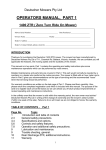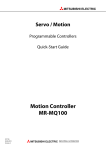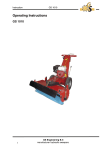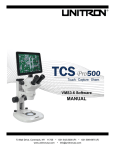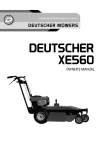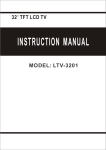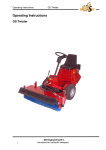Download OPERATORS MANUAL, PART 2
Transcript
Deutscher Mowers Pty Ltd OPERATORS MANUAL, PART 2 1400 ZTR ( Zero Turn Ride On Mower) Table of Contents Page No 1, 2 2 3 4 5 6 7 8 9 10 - 18 10 11 12 13 14 15 16 17 18 19 Topic Table of Contents and Outline of Machine Functions. Service Schedule Adjustments, belt tensions, control levers. Adjustments, handbrake. Trouble Shooting Guide and Electrical System. Removal, replacement of the mower deck. Removal, replacement of the engine/ clutch assembly. Removal, replacement of the hydrostatic transmission units. Wiring diagram Exploded view drawings and parts lists. Seat and lid Electrical components Chassis Height adjusting mechanism Operators controls Handbrake components Engine and rear wheel drive Deck assembly drawing Deck assembly parts list Rear discharge version – component parts. Outline of Machine Functions The Deutscher 1400ZTR ride on mower is fitted with a Briggs & Stratton engine or a Honda engine. Both engines use a 12v starter system with its own charging system. A key switch is used to start the engine on the control panel. A single V belt is used to drive the transmissions from the engine. The hydrostatic transmission units have an output shaft whose speed and direction of rotation can be varied independently of the input shaft speed and rotation direction. The output shaft of the left hand hydrostatic transmission is attached to the left rear wheel and the output shaft of the right hand hydrostatic transmission is attached to the right rear wheel. A single “fixed position” idler pulley adjacent to the engine is used to keep the drive belt tight. The two hydrostatic transmission units are controlled by levers, as described in Part 1 of this manual, and do not turn the wheels when the levers are in their neutral position. The front wheels of the mower are “castors” and free to pivot in any direction. An electric clutch on the engine is used to engage the cutters via a B section belt. The clutch is switched on and off by a switch on the operators panel. The fully floating side discharge “1400mm cut width” mower deck is suspended on four chains below the frame of the mower, and is held forward by a V shaped frame which is adjustable in length.( To tighten the deck drive belt). This ensures that the deck drive belt remains tight when the deck is raised and lowered. 1 The mower deck is fitted with three disc blades, and the central blade is driven by the long belt from the engine. The two outer blades are driven by separate belts from pulleys on the central blade shaft. These outer belts can be separately tensioned. The mower deck is braced sideways with a long steel rod which can move up and down as the deck height is changed. The rod is spring loaded at the end to absorb minor collisions, by allowing the deck to swivel slightly. Raising the mower deck is accomplished by the operator pushing on a foot pedal which in turn moves a mechanism to lift the deck. A large spring attached to the mechanism reduces the force required for the lift. The deck will descend to its lowest height by gravity once the pedal is pushed slightly and a pin is removed from the long height adjusting rod. A lid under the operator’s seat allows easy access to the battery and the fuses. The mower is fitted with a toolbox on the left mudguard, but this can be replaced with a fuel tank as an optional extra.( This will double the fuel capacity.) Lastly the mower has many safety features as mentioned in Part 1. These include an interlock which prevents the mower being started when the handbrake is off, an interlock which stops blade rotation when the handbrake is applied, a seat switch which turns off the engine if you dismount and a switch under the battery lid which prevents the engine being started when the lid is raised. The handbrake is incorporated in the right hand control lever, so when the lever is moved aside to exit the seat, the handbrake is automatically applied. Service Schedule * Frequency 100hrs Component Engine cooling air screen. Cooling Fins, engine 100hrs Engine air cleaner 25 hrs Spark plugs Fuel filter Battery Hydrostatic units Belts Tyres Handbrake 100hrs 100hrs daily 10hrs or daily 50hrs 30hrs As required Hydro L shaped control lever. 10 hrs 10hrs Type of Maintenance Brush clean. Clean with air hose if available,(USE SAFETY GLASSES), otherwise by hand. Shake out dirt dry type. Wash sponge type pre-cleaner. When not serviceable, replace. Service or replace Replace Check water level, top up if necessary. Externally clean. (assists cooling) Check for wear and adjust. Check for damage and air pressure. Adjust linkage. (If the mower can be pushed with the handbrake engaged.) Lubricate mechanism pivot points with light oil. Lubricate pivot bolt with light oil. * More often under extreme conditions. 2 Adustments 1. Deck drive belt ( From engine to mower deck ) To check the belt tension, reach in to the centre of the belt, at the rear of the mowing deck, and grasp the two sides of the belt in one hand. i.e. With your thumb around one side of the belt and your little finger(s) around the other side, Squeeze your grip to test the belt tension. You should have about 15 mm movement inwards on each side. Do not over-tighten the belt. This may reduce bearing life etc. To tighten the belt, loosen the front ¾” UNC nut on the large thread at the front of the mower deck by a few turns. Turn the second nut on the same thread clockwise (facing forward) and with each half turn recheck the belt tension as described above. Retighten the front nut. 2. Short blade belts (On mower deck) It is easier to tension these belts if you have the deck removed, but it can be done with the deck on the mower, and even with the belt guards in place. To tighten these belts, simply loose the 3/8” UNC nuts on the belt idler pulleys, push the pulleys inwards by hand and retighten the nuts. It may be useful to place a piece of wood behind the idler bracket when pushing it in. Once tightened, the belt should deflect about 12-15 mm in the centre opposite the idler pulley when forced inwards by hand. Important! The idler pulley runs on the outside of the belt. Using incorrect belts can cause premature belt failure, as not all belts are designed for this arrangement. 3. Hydrostatic transmission belt. (Under the engine) Remove the left rear cover. (situated above the bumper bar) To tension the belt, loosen the 8mm tensioner clamping bolt (on the left of the left engine mounting plate) by one to two turns. Push the belt idler inwards with a force of approximately 5 – 8 kg, and while holding this force, retighten the 8mm bolt. OVERTIGHTENING THE BELT COULD CAUSE PREMATURE FAILURE OF THE HYDRO BEARINGS. THE 5 – 8 kg FORCE IS ABOUT THE MAXIMUM MOST PEOPLE CAN ACHIEVE WHEN PUSHING ON THE TENSIONER WITH THEIR THUMB. IF UNSURE OF THE FORCE REQUIRED, USE A PIECE OF FLAT WOOD AND A SPRING BALANCE. DO NOT USE A LEVER TO TIGHTEN THE BELT TENSIONER. YOU WILL VOID YOUR WARRANTY. You can check the belt tension by pushing the belt sideways at a point halfway between the right hydro pulley and the engine pulley. The belt should deflect about 12mm when pushed sideways forcefully with your thumb. 4. Hydrostatic Transmission control levers If the two control levers are not opposite each other, or you wish their neutral position to be further forward or backward, simply loosen the 8mm bolt (13mm spanner) at the base of each lever (facing inwards), relocate the levers and retighten the bolts. The length of the hydro control rods inside the mower are factory set and should not need adjusting. 3 5. Handbrake To test the handbrake, park the mower on a smooth level surface and put the right hand control lever in its “OUT” position. Try to push the mower with the freewheeling levers engaged. If the mower moves, adjust the handbrake as follows. With the right lever in the “IN” position, the free play on the handbrake lever where it joins the control lever rod, should be approximately 1-2mm.( See diagram 1). If the free play is greater, tighten the nut on the handbrake rod at the base of the machine under the front of the battery, until the required free play is achieved. Recheck the handbrake operation by trying to push the mower with the brake engaged. If the method listed above fails to improve the handbrake function, the two castellated nuts on the sides of the hydro units, at the rear, may need tightening. Please note there should still be a small amount of free play in the levers under these nuts when the handbrake is off. Remove the split pins to turn the castellated nuts, and replace the pins after winding in the nuts by hand. 6. Deck Tilt and Minimum Deck Height If the deck is scraping on the ground at its lowest height, it can be raised at the front by relocating the “pins holding the chains on the front of the deck” further rearward in the multi-holed brackets.( the multiholed brackets are welded to the top of the deck). To raise the rear of the deck, remove the platform ( see para 2, page 6) and then tighten the nuts on the long height adjusting rods. The nuts are on the left and right side of the mower, roughly near the height adjusting pedal and the foot support. As you tighten, periodically measure the gap between the top of the deck (at the front and the rear) and the side rails. The gap should be the same front to rear or say 10mm narrower at the rear. A slight downward slope of the blades can produce a better cut. Finally check that the four chains are tight. If one of the chains is loose, tighten the nut on the long rod on the same side as the loose chain. 7. Removal of the Large Deck Spring Remove the deck as described above, and the platform as described in para 2, page 6. Slide the pedal well forward on the height adjusting rod (i.e. the rod with the multiple holes). Grasp the height adjusting rod firmly and pull it towards the rear of the machine, at the same time removing the pin you placed behind the bracket at the right front corner of the seat. Now allow the rod to move forward slowly, until it stops. Use a strong wire hook or sturdy rope, connected to the front of the spring, to pull the spring forward and then down off the torsion bar bracket. 4 Trouble-shooting Chart Problem Mower will not start when the key is turned. Possible Cause • Right hand lever in “IN” position. • Blown fuse in starter solenoid circuit. • Driver not sitting in the seat. • Engine/ starter motor fault. • Flat battery. (Especially if the starter solenoid clicks but the engine does not turn over) • Circuit fault. Follow circuit diagram, page 9. Battery will not charge. • Corroded or loose battery terminals. • Defective battery. • Inoperative diode or rectifier/regulator. Battery discharges rapidly. • Low water level. • Defective battery. Engine cranks slowly • Weak or discharged battery. • Corroded or loose electrical connections on the solenoid or the battery. Blades will not turn when • Right hand control in the “OUT” position. switched on at the panel. • Clutch fault. Check power is getting to the clutch before removing the clutch. • Belt missing or slipping. See “adjustments” • Circuit fault. Follow circuit diagram, page 9. Engine will not turn off when • Faulty ignition switch. the key is turned off. • Open circuit in engine earthing lead, either between the engine and key switch, or between the key switch and earth. Engine will not turn off when • The switch under the seat is not operating when the seat lifts. leaving the seat, without • There is an open circuit in the earth wire from the engine to turning off the ignition key. the switch or from the switch to the chassis earth. Poor grass discharge from • Blades badly worn chute. • Belts slipping. • Mower deck set too low for the conditions. • Driving too fast for the conditions. • Grass very wet. Mower turning to the left or • Control levers need adjusting. See “Adjustments” right with the control levers • Hydro belt slipping. To check, see “Adjustments” held opposite each other. • One or both hydro units faulty. See your mower dealer. Mower not climbing up hills. • Tyres slipping on grass. • Hydro belt slipping. • Faulty hydro units. Electrical System Ref. Wiring Diagrams on Page 9. 1. The diode in the clutch circuit is installed to prolong switch life. FAILURE TO CONNECT THE DIODE CORRECTLY WILL CAUSE A SHORT CIRCUIT. 2. The switch connected to the right hand control lever has a second function; it prevents the mower being started unless the control lever is in the out position. This ensures the handbrake is engaged when the mower is started. 3. See page 6, Part 1. The buzzer is installed to warn operators that the battery will go flat if they leave the seat and do not turn off the ignition switch. 5 Deck Removal and Replacement Removal 1. Position the mower on a level area where you wish to remove the deck, stop the engine, engage the handbrake and lower the deck to its lowest height. 2. Loosen the large ¾” UNC nut at the front of the deck, in the centre under the front cross beam. Then loosen a similar nut at the rear of the same bracket, so the blade drive belt from the engine becomes slack. Removing the foot platform will make access to these nuts easier. To remove the platform, pull the pin out of the height adjusting pedal and slide the pedal rearwards until it touches the control panel. Remove the four screws retaining the platform. Remove the platform by standing at the front, with your left hand in the slot through which the height adjusting mechanism protrudes and your right hand under the right edge, then lift it aside. 3. Remove the long blade drive belt from the pulley on the deck. 4. Pull out the pin securing the deck sway brace to the mower. The pin is located at the base of the chassis, just in front of the left hand wheel. Pull the sway brace bar off its support pin but leave it connected to the deck. 5. If you removed the pin from the height adjusting pedal, slide the pedal forward so it is at least 300 mm away from the control panel. Grasp the height adjusting rod (the long square tube with the pedal on it) firmly and pull it towards the rear of the machine until the chains supporting the deck are loose. Place a bolt or the pedal pin in one of the height adjusting holes, just behind the guide bracket at the front right hand side of the seat, then slowly release your grip on the rod. The four deck chains should remain loose. 6. Pull out one of the R clips on the main deck pin at the front of the deck, and remove the pin. Lift the V frame off the deck and place a short piece of pipe or plastic tube over the front height adjusting system torsion bar and onto the belt tensioning bolt. This will hold the V frame off the deck. 7. Remove the four pins at the bottom of the chains which support the deck. 8. Release the handbrake on the mower and the 2 freewheeling levers at the rear of the mower. Grasp the front cross beam of the mower, lift the beam and walk the mower backwards over the deck. Replacement Replacing the deck is the reverse of the above sequence. 6 Engine/Clutch Removal Removal 1. The clutch cannot be removed from the engine when it is in the in the mower, so to service the clutch or the engine, remove the engine and clutch as an assembly. The engine mounts have been cut away so this can be accomplished relatively easily. 2. Use only an approved crane or engine lifting device to lift the engine form the mower. 3. Turn off the ignition key or disconnect the battery. Release the power lead to the clutch by unplugging it on the inside of the firewall, then loosening the cable clamp. Remove all other wires leading to the engine, being careful to tag them (for ease of replacement) before they are removed. 4. Remove the covers on either side of the engine. 5. Remove the blade drive belt as described in “Deck removal and Replacement”. 6. Release the tensioner for the hydro drive belt and pull the tensioner fully backward in its slot. If this does not enable you to remove the hydro drive belt easily, remove the tensioner completely. Remove the hydro drive belt. 7. Drain the engine oil. See engine booklet. 8. Disconnect the fuel line from the engine, being careful not to spill fuel. DO NOT SMOKE OR PERFORM THIS TASK ANYWHERE NEAR A NAKED FLAME. TURN OFF MOBILE PHONES. 9. Remove the four engine bolts and the spacer above the strap to the clutch. Note carefully the position of the clutch strap. i.e. on the right side, with the spacer ABOVE the strap. The strap must be in tension with the engine running and blades driving. 10. Loosen the other end of the clutch strap and turn it in towards the crankshaft. 11. Place strong straps around the engine and, using a winch rated for the purpose, carefully raise the engine and clutch assembly. Never position yourself under the assembly once it is raised, and keep bystanders away. Lift the engine just above the rear of the mower and lock the lifting device. 12. Release the freewheeling levers on the back of the mower, and slowly draw the mower away from the engine. 13. Lower the engine carefully to the ground or bench and sit it on blocks. Replacement Replacement of the engine clutch assembly is the reverse of the installation. Great care must be taken to avoid damaging the clutch pulley during this operation. Don’t forget to reconnect the clutch strap, and to tension the belts as described in the “Adjustments” section. Ensure no contamination gets into the fuel line, as this will end up in the carburettor. 7 Hydrostatic Transmission Removal/ Replacement Removal 1. This task is a lot easier with the engine/ clutch assembly removed, the seat removed and the battery box removed. IT IS IMPERATIVE THAT THE MOWER IS ON A LEVEL SURFACE. 2. To remove the seat, disconnect the wiring under the seat, but carefully tag the wiring first. Then remove the bolt/ hinge pin on the left front corner of the seat. Slide the seat panel to the left and it will come off the right hand hinge pin. 3. To remove the battery box, first take off the battery strap, then remove the battery. Next undo the bolts on either side of the battery box, and remove the box. 4. Using a jack, mount the rear of the machine on 2 car stands positioned near the two rear corners and under the side plates. 5. Remove the two rear wheels. 6. Disconnect the pin across the rear of the machine, underneath the clutch pulley, which is connected to the handbrake levers on the rear of the hydro units. Remove the spring which is connected to the handbrake rod, on top of the chassis. Slide the handbrake rod forward. 7. Remove the springs from the ends of the freewheeling levers, then remove the levers from the hydro units. Withdraw the levers from their guides and place them aside. 8. Remove the frame (chassis) from underneath the hydro units. IF YOU PUT YOUR ARM UNDER THE MACHINE, ENSURE THE MOWER IS VERY SECURE ON THE CAR STANDS. A security block or drum under the centre of the machine is recommended. 9. The hydro units can now be removed by disconnecting and removing the bolts which hold them to the chassis side plates. If you do not have sealing plugs for the hydro units, keep the plastic tubular vent facing upwards at all times, even during removal. Replacement Replacement of the hydro units is the reverse of the installation. Ensure the wheel bolts are tensioned to 40ft lb, 54 Nm, and the engine bolt through the clutch is tightened to 50ft lbs, 68 Nm. Use new nyloc nuts on the hydro bolts if they have been removed more than once before. DO NOT FORGET TO REINSTATE THE VENT PIPES IN THE HYDRO UNITS. Tension the blade belt and the hydro belt as specified in the “Adjustments” section. 8 WIRING DIAGRAM – BRIGGS and STRATTON ENGINE Wire No. / end fitting/ length mms, colour / end fitting 1 FS (870,yellow)MS (50 , yel) B – diode - B (100, yellow) O 2 FS (510, yellow) FS 3 FS (300, blue) FS 4 FS (770 , blue) FS 5 FS (630,red) FS 6 FS (820,red) FS 7 FS (280,green) O 8 O (500,green) FS (80,green) FS 9 O (110,green) MS 10 FS (600,grey) FS (160, yellow) FS (430,yellow) FS (540,red) B 11 12 13 14 15 16 17 FS (300,black) B FS (490, green) O FS (650,black) FS (760, black) MP FS (120, grey) FR FS (50,red) FS (300,red) O FS (110,blue) FS FS (110, red) FR Wires 1 – 17 are pvc coated, 2.2mm diameter. End fittings = FS (1/4” female spade), MS (1/4” male spade), O ( ¼” round hole), FR (4mm female round socket), MP ( 4mm male round pin), B ( bare end, 15mm wire) WIRING DIAGRAM – HONDA ENGINE Wire No. / end fitting/ length mms, colour / end fitting 1 FS (870,yellow)MS (50 , yel) B – diode- B (100, yellow) O 2 FS (510, yellow) FS 3 FS (300, blue) FS 4 FS (770 , blue) FS 5 FS (630,red) FS 6 FS (820,red) FS 7 FS (280,green) O 8 O (500,green) FS (80,green) FS 9 O (110,green) MS 10 FS (600,grey) FS (160, yellow) FS (430,yellow) FS (540,red) B 11 12 13 14 15 16 17 FS (300,black) B FS (490, green) O FS (650,black) FS (760, black) MP FS (120, grey) FR FS (50,red) FS (300,red) O FS (300, blue) FS FS (110,red) FR Wires 1 – 17 are pvc coated, 2.2mm diameter. 9 PARTS LISTS SEAT and LID Item No 1 2 3 4 5 6 7 8 9 10 11 12 13 14 Part No 1394 1072 1407 1019 1018 1017 1040 1817 1330 1371 1372 1819 1058 1059 Part Description Seat spring (was T535) Nut 8mm Plastic cap, spring (was T536) Washer 8 x 20 Spring washer 8mm Bolt M8 x 20 Seat switch stud Microswitch bracket Standard seat, KAB P2 Delux seat, KAB U2 Back rest, KAB P2 seat Seat base plate Bolt3/8” UNC x 1” Washer 3/8” x 1” Item No 15 16 17 18 19 20 21 22 23 24 25 26 27 10 Part No 1818 1063 1062 1054 1019 1099 1816 1821 1815 1945 1946 R87 1132 1814 Part Description Seat hinge bracket Bush – seat pivot Nut, 3/8’ UNC nyloc Seat lid assembly Washer 8 x 20 Nut 8mm nyloc Earthing strap Washer 50 Dia Engine cutout spacer Nylon insulator Nylon washer Spring, Standard seat Spring, delux seat Engine cutout plate ELECTRICAL COMPONENTS Item No 1 2 3 4 5 6 7 8 9 10 11 12 13 Part No 1263 1373 1374 1395 1396 1397 1810 1398 1811 1154 1259 1260 1254 1253 1252 Part Description Lid & handbrake switch Battery cable (245mm) Battery (was T315) Engine earth lead. (180mm) Throttle plate assembly - B&S Choke cable assembly – B&S Choke cable assembly - Honda Throttle cable assembly - B&S Throttle cable assembly- Honda Cable clamp Screw 5mm x 15 Nut 5mm, nyloc Fuse 10 amp (2 off) Fuse 20 amp (2 off) Fuse box Item No 14 15 16 17 18 19 20 21 22 23 11 Part No 1255 1135 1261 1262 1256 1333 1947 1250 1712 3063 Part Description Starter solenoid (B&S only) Control panel Key switch Blade switch Hour meter Electric clutch Micro switch Wiring loom, incl buzzer Buzzer Battery cable (Honda 560mm) CHASSIS Item No 1 2 3 4 5 6 7 Part No 1187 1329 1393 1399 1364 1311 1370 8 9 10 11 12 13 14 15 16 17 1129 1120 1119 1004 1003 1308 1376 1145 1140 1143 Part Description Tank strap (2 off) Tank cap Fuel tank including inlet fitting Hose clamp Tank outlet hose Bumper bar plug (2 off) Roll over protection bar assy (optional extra) Bumper bar assembly Battery clamp Battery box Engine cover RH Engine cover LH Toolbox Chassis assembly Plastic knob Footrest plate Coach bolt Item No 18 19 20 21 22 23 24 25 26 27 28 29 Part No 1136 2087 1064 1191 1198 1199 1192 1193 1356 1357 1201 1200 30 31 32 - 1202 1353 1354 1760 33 1231 12 Part Description Platform assembly Hydro support bracket Subframe Bearing cap Circlip Bearing ( 6205-2RS ) Kingpin assembly RH Kingpin assembly LH Outside rim, front wheel Inside rim, front wheel Bearing spacer Front wheel bearing ( 6203-2RS ) (Two per wheel.) Wheel nut Tube, front wheel Tyre, front wheel Complete front wheel including tyre and tube. Wheel bearing cap (was R100) HEIGHT ADJUSTING MECHANISM Item No 1 2 3 4 5 6 7 8 9 10 11 12 Part No 1358 1276 1153 1378 1059 1436 1167 1171 1062 1172 1173 1437 Part Description Cable, height adjusting pin Height adjusting pin Self tapping screw Washer 3/16” Plain washer 3/8” ID Bolt, 3/8” Whit x 1” Chain, 5 links R clip Nyloc nut 3/8” UNC Deck pin Height adjusting tube Bolt, 3/8” Whit x 2” Item No 13 14 15 16 17 18 19 20 21 22 23 13 Part No 1159 1183 1178 1379 1174 1359 1166 1175 1062 1053 1160 Part Description Lift lever, rear deck Pedal pin Pedal assembly Bolt 3/8” Whit x 3” Height adjusting rod Plastic plug Spring, deck lift Height adjusting swivel Nyloc nut 3/8” UNC Stepped bolt Torsion tube assembly OPERATOR’S CONTROLS Item No 1 Part No 1106 2 3 4 5 6 7 8 9 10 11 12 13 14 15 16 17 18 1114 1109 1112 1098 1103 1091 1099 1417 1059 1416 1072 1019 1328 1097 1081 1113 1116 Part Description Control lever assembly, L&RH (Includes items 2,3,4, 17 & 18.) Handgrip set Release assembly Plastic knob Bolt M8 x 30 Rose joint , 5/16” UNF Vertical rod, hydro control Nyloc nut M8 Nut 10 mm Washer 3/8” x 1” Bolt M10 x 40 Nut M8 Washer 8 x 20 Bolt M8 x 50 Support, RH control Support, LH control Spring, release assembly Pop rivet Item No 19 20 21 22 23 24 25 26 27 28 29 30 31 32 33 14 Part No 1118 1117 1404 1428 1073 1085 1076 1314 1132 1344 1133 1096 1342 1088 5002 1093 Part Description Bolt M8 x 40 Nylon roller Over-travel device - assembly Nut 5/16” UNF Pivot block assembly Nylon bearing half (2 each side) RH control assembly Split pin Spring RH control 5/8” x 1” washer Spring, LH control LH control assembly Bolt M8 x 25 Right angled lever ( 2 off) Bronze bush ( not shown, fits in lever No 32.) ¼” W threaded rod HANDBRAKE COMPONENTS Item No 1 2 3 4 5 6 7 8 9 Part No 1082 1017 1099 1029 1030 1019 1350 1031 1028 Part Description Top plate, handbrake pivot Bolt M8 x 20 Nyloc nut M8 Hydro lever, handbrake Roller tube Washer 8 x 20 Split pin Handbrake tie rod Rod assembly, handbrake Item No 10 11 12 15 Part No 1352 1345 1015 Part Description Tension spring Handbrake lever assembly Washer ½” ENGINE and REAR WHEEL DRIVE Item No 1 1A 2 3 4 5 6 7 8 9 10 11 12 13 14 15 Part No 1331 1386 1016 1015 1014 1017 1018 1019 1013 1011 1272 1024 1020 1267 1268 1340 Part Description Engine, B&S Engine, Honda Nyloc nut M12 Washer ½” x 1” Idler pulley ½” x 3” (was T618) Bolt M8 x 20 Spring washer 8mm Plain washer 8 x 20 Bolt M12 x 45 Idler arm Drive belt Spring Latch assembly Hydrogear transmission, LH Hydrogear transmission, RH Rear tyre 20” Item No Part No 16 1341 17 1383 18 1339 19 2064 20 1338 21 1333 22 1270 23 1271 24 1335 25 1336 26 1337 27 1400 27A 1380 28 1384 29 1381 16 Part Description Wheel nuts Rear wheel rim Crankshaft bolt 7/16” x 3” UNF Spring washer 7/16” Stepped collar Clutch Clutch strap Clutch strap spacer ¼” key x 29 Pulley 4” Collar, crankshaft top Muffler B&S Muffler Honda Cap screw 5/16”x20 UNC Muffler gasket MOWING DECK ASSEMBLY 17 Mowing Deck Parts List Item No 1 2 3 4 5 6 7 8 9 10 11 12 13 14 15 16 17 18 19 20 21 22 23 24 25 26 27 28 29 Part No 1228 1274 1227 1316 1046 1049 1015 1245 1203 1210 1247 1275 1014 1428 1018 1019 1241 1243 1233 1237 1171 1239 1094 1238 1000 1286 1292 1291 1273 Part Description Belt cover RH V belt, deck drive Belt cover LH Bolt ½” x 3” HT UNF V frame pivot bush Nut, ½” UNF Plain washer ½” Spring washer ½” V frame assembly Nut 3/4” UNC Spring washer 3/4” V belt, deck outer Idler pulley 3” Nut 5/16”UNF Spring washer 8mm Plain washer 8mm Blade belt tensioner (Left hand) Blade belt tensioner (Right) Sway brace Washer ½” x 7/8” R clip Split pin ( 3/16” x 1”) Spring, sway brace Washer ½” x 1” x 1/8” Plastic discharge chute Hinge plate assembly Hinge pin – flap Starlock clip, 8mm Flap spring Item No 30 31 32 33 34 35 36 37 38 39 40 41 42 43 44 45 46 4750 51 52 53 54 18 Part No 1105 1314 1282 1279 1211 1248 1171 1207 1319 1325 1296 1323 1320 1385 1388 1294 1406 H651 H650 H652 G36 1060 R32 1382 Part Description Roll pin 3mm x 20 Split pin 3mm x 25 Axle, deck roller Deck roller Deck frame – Welded to item 55 on later models. Deck retaining pin R clip V frame coupling Nut 1” UNF Centre pulley assembly Key ¼” x 80 Double pulley (1 off) Outer pulley,deck (2 off) Spindle assembly, outer Spindle assembly. Centre Spindle housing Spindle bearing (6206. 2NSE) Blades only x 2 Blade, bolt, nut,washer x 2 Bolt, nut, washer set x 2 Disc retaining bolt Spring washer 3/8” Blade plate assembly Deck welded assembly Rear Discharge Version - Components Item 1 2 3 4 5 6 7 8 9 10 11 12 Part No 1769 1957 1762 1775 1062 1058 1776 1799 1804 1785 1791 1792 Part Description Rear discharge deck assembly. Honda muffler VSM3 Self threading screw Chassis plate Nut, nyloc, 3/8” Bolt, 3/8” x 1” Bumper bar assembly, rear discharge. Air cleaner, Honda No. Air cleaner hose. Air intake extension - adaptor Hose Clamp 25 - 40 mm (2off) Hose clamp 40-60 mm (1 off) 19



















